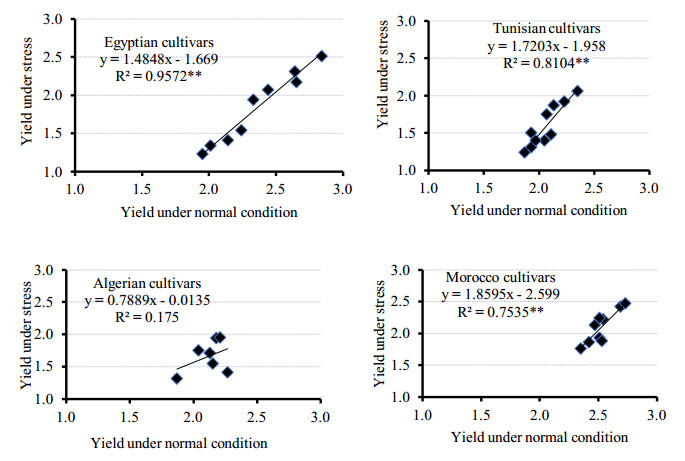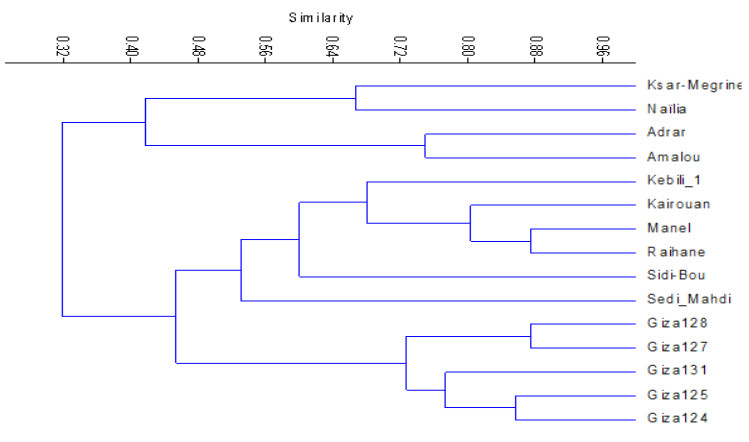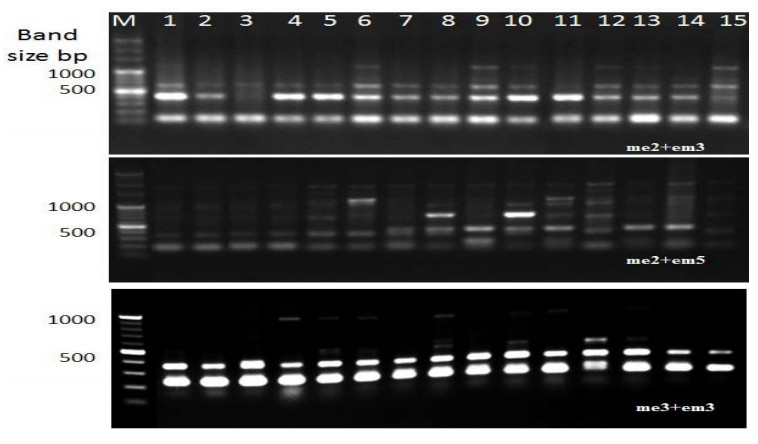This study examined Sweet Potato (SwP) production efficiency in Nigeria. A multi-stage sampling technique was employed in selecting 93 SwP farms in February, 2016. Data on farm and farmers’ characteristics, input and output quantities and prices, constraints to SwP production among others were collected using pre-tested, well-structured questionnaire. The data were analysed with descriptive statistics, Data Envelopment Analysis (DEA) and Tobit regression. The results of the analysis revealed that the mean Technical Efficiency (TE), Allocative Efficiency (AE), Economic Efficiency (EE) under Constant Return to Scale (CRS) assumption were 0.685, 0.445 and 0.301 respectively. On the other hand, the TE, AE and EE under Variable Return to Scale (VRS) assumption were 0.783, 0.604 and 0.467 respectively. The Scale Efficiency (SE) was found to be 0.877. The results indicate that access to credit increased TE of farms by 3.5%. Regular training of SwP farmers increased their AE by 10.5% and EE by 16.6%. Access to credit by farmers decreased SE of farms under CRS and VRS by 1.9% respectively. Labour shortage, poor access to improved technology and infestation by insect pests were the three most important constraints limiting SwP production in the study area. Therefore, improving the efficiency of SwP production will require policies that will see to regular training of farmers by extension agents and other stakeholders and enhancement of rural farmers’ access to credit.
1.
Introduction
Drought is a meteorological event which affects the crop productivity due to the absence of rainfall over a period of time, decreasing the soil moisture content and cause a decline of water potential in plant tissues. Nezhadahmadi et al.
[1] concluded that by the year 2025, around 1.8 billion people will face water scarcity and 65% of the human population will impose to water stress condition. Passioura [2] stated that the grain yield of crops under water limited condition is determined by three components: (i) water use as the amount of water transpired by crops, (ii) water use efficiency in producing biomass per unit of water used and (iii) the harvest index, the ratio between grain yield and total biomass.
Drought is a major a biotic stress defined as the plant's ability to maintain a relatively high plant water status or cellular hydration despite water deficit, so that plant functions are relatively unexposed to tissue dehydration [3,4]. The ratio between the water requirement for the growth of the plant and the available water in its environment known as water stress, whereby the useful reserve of water for the plant is the amount of water soil accessible by its root system. The plant response to water stress depends on the genotype, the length and severity of water deficit and developmental stage [1].
Barley ranked fourth in cereal crop after wheat, rice and maize [5]. Barley has the least importance in Egypt among the cereal crops and cultivation confined to marginal lands associated with drought and saline conditions. It is the mainly grown in the Northern coastal regions where the average annual precipitation is about 135 mm in North West Coast, and slightly higher in North Sinai [6]. Barley includes three mechanisms for coping with drought stress [7]: Escape, avoidance, and tolerance. Varieties from regions characterized by terminal drought (drought at the reproductive stage) complete their life cycle before the onset of severe water deficit [8], which is consistent with a drought escape strategy [9]. Adaptations conferring drought resistance divided into alternative strategies including drought escape (rapid development to complete a life cycle before drought) and drought avoidance (reducing water loss to prevent dehydration) [10].
Therefore, the present study conducted to identify the drought tolerance Mediterranean barley varieties grown under water stress condition which could be recommended for cultivation in the aridic climate of Northern African regions.
2.
Materials and methods
Field experiments conducted during winter seasons of (2016/2017 and 2017/2018) to characterize the Mediterranean barley (Hordeum vulgare L.) varieties grown under water stress condition of the experimental research station of National Research Centre, Nubaria region, Egypt (latitude 30.87 N, and longitude 31.17 E, and mean altitude 21 m above sea level). The experimental research area classified as arid regions with cool winter and hot dry summer prevailing in the experimental area. There was no effective rainfall (low intensity) that can be taken into consideration throughout the two growing seasons and to the pacing between rainfall events.
The soil of experimental site is classified as sandy soil. The field capacity and available water of the experimental soil was 15.7 and 11.4 mL/100 g soil, respectively. Soil pH was 7.8; Electrical conductivity 1.1 dS m−1 and available N, P and K were 34.6, 6.6 and 18.8 mg/kg soil, respectively. The experiment was arranged in randomized complete block design with three replicates where the varieties origin (countries) in main plot and the water regimes (75 and 40% of water holding capacity named as normal and stress condition) imposed in the subplot. The field experiments were drip irrigated with tow emitters discharge (4 and 2 liter/h, to resemble normal irrigation (full irrigation as recommended- none stressed condition) and stress conditions (water deficit), respectively and lateral length (25 m) and a meter among. Mediterranean barley varieties under investigation were:
(1).Egyptian varieties: (Giza 123, Giza 125, Giza 126, Giza 127, Giza 130, Giza 131, Giza 2000, El-Arich and Ksar)
(2).Tunisian varieties: (Kebili 1, Tozeur-2, Kebili 3, Kairouan, Manel, Raihane, Sidi-Bou, Sabra, Tombari, Lemsi)
(3).Algerian varieties (Temacine, Ksar-Megrine, Techedrett, Saida, Sedi Mahdi, Ras El-Mouche, Naïlia).
(4).Morocco varieties: (Adrar, Oussama, Amalou, Massine, Taffa, Firdaws, Amira, Tamellalet, Laanaceur).
The grains of the all cultivated barley varieties obtained from National gene bank of Tunisia. All agronomic practices followed during the growing season as recommended by the Agricultural Research Centre, Ministry of Agricultural and Soil Reclamation, Egypt.
2.1. Yield components estimation
At harvest, the total area of each plot harvested to determine the potential grain yield (Yp-yield observed after full irrigation) and stress yield (Ys-yield observed after deficit irrigation) per plot and then converted to grain yield ton acre−1. Plant height (cm), height of ten random plants per plot measured at a distance from the bases of the culms to the tips of the spikes. Data collected averaged to be per plant. Number of Spikes m−2, number of spikes taken randomly from inside each plot, and then transformed into spikes per square meter. Spike weight (g) expressed as average of ten spikes weight from each plot. Thousand-kernel weight (g), estimated as the weight of 1000 cleaned kernels in gram for each plot. Biological yield, total biomass (grain and straw) of the harvested plants (Kg m−2) weighted, then transformed into a ton per acre. Harvest index (HI) = grain yield/biological (grain + Straw) yield into 100. Water use efficiency (WUE), expressed in; kg m−3) on grain basis and determined by dividing the grain yield (kg acre−1) by the quantity of water applied (m3 acre−1).
2.2. Drought tolerance indices
Drought tolerance indices calculated by the equations cited in Table 1.
2.3. Molecular markers associated with water stress tolerance
DNA isolated using CTAB [17] and the PCR (BioRad, T10 Thermal cycler, USA) reactions using SRAP marker used in this study. For SRAP, initial denaturation at 95 ℃ for 5 min, then five cycles 1 min, denaturation at 94 ℃, 1 min, annealing at 35 ℃, and 45 S of elongation at 72 ℃. In the following 30 cycles, denaturation at 95 ℃ for 1.5 min, annealing at 50 ℃ for 1 min, and elongation at 72 ℃ for 45 S. PCR products separated by electrophoresis using 1% agars gel in 1× TAE buffer against 100 bp DNA Ladder as a size marker. Bands were detected by Ethidium bromide staining and visualized under UV light, then photographed on gel documentation (gel image system). The electrophoretic of the reproducible banding patterns of each primer were chosen for analysis. Each band scored as present (1) or absent (0), and pairwise comparisons between individuals made to calculate the Jaccard coefficient using the PAST program.
2.4. Statistical analysis
It was computed for each possible pairwise comparison of the drought tolerance indices and the significance of the rank correlation coefficient tested [18]. Mean data collected from two seasons statistically analyzed as a Randomized Complete Block Design (RCBD) using analysis of variance (ANOVA) and the means of the varieties included in this trial compared using Fisher test run by Least Significant Difference (LSD) at (P ≤ 0.05) [19].
3.
Results
3.1. Plant height, spike weight
Data on yield characteristics of the Mediterranean barley varieties observed in Table 2, the highest of the plant height attained at barley variety Massine (Morocco) followed by Tozeur-2 (Tunisian), Giza 131, Giza 2000 (Egyptian) and Techedrett (Algerian) under normal condition while same varieties took same trend under stress condition. Meanwhile, the lowest values of the same variable (plant height) observed at Ras El-Mouche (Algerian) < Adrar (Morocco) < Ksar (Egyptian) < Sabra (Tunisian) under both studied conditions. Also, it is clear to mention that the differences between the highest and the lowest values for the investigated barley varieties were 17, 19, 25; 28% in the same sequences mentioned above.
Regarding to the number of spikes per m2, spike weight, the barley varieties Giza 123 (Egyptian) and Ras El-Mouche (Morocco) gained the highest values under normal condition, while Giza 131 (Egyptian) and Temacine (Morocco) gained the highest values under stress condition. Whereas, the lowest values of the number of spikes per m2, spike weight obtained at Taffa (Morocco), Manel (Tunisian), Giza 125 (Egyptian) and Saida (Algerian) for number of spikesm−2 under normal condition and Tamellalet (Morocco), Sabra (Tunisian) and Sedi Mahdi (Algerian) under stress condition. Lemsi (Tunisian) < El Arish (Egyptian) < Adrar (Morocco); Ras El-Mouche (Algerian) scored the lowest values of spikelet /m2, spikelet weight in descending order.
The barley yields characters (1000 kernel weight, biological yield and grain yield) under normal and water stress conditions stated in Tables 2 and 3. Data on hand revealed that Giza 2000 (Egyptian), Kebili (Tunisian), Techedrett (Algerian), Laanaceur (morocco) gained the highest values of the previous characters under both normal and stress conditions while, the lowest values of 1000 kernel weight recorded for the barley varieties Giza 130 (Egyptian), Sabra (Tunisian), Ras El-Mouche (Algerian) and Adrar (Morocco). It is clear to mention that Laanaceur (Morocco) scored the highest values of 1000 kernel weight under both studied conditions. In case of the lowest values of 1000 kernel weight obtained at Giza 130 (Egyptian), Tombari (Tunisian), Ras El-Mouche (Algerian) and the Adrar (Morocco).
Obtained data pointed out that the most tolerant varieties to the drought stress relative to the lowest reduction percentage which observed at Giza 2000 and Giza 131 in same sequences. Regardless, stress effect, Giza 131 scored highest values of the plant height, number of spike/m2 and spikelet weigh growth characters of barley and Giza 127 and Giza 2000 gained the highest values for spikelet length and 1000 kernel weight, respectively.
3.2. Grain and biological yield
Regarding to the biological yield (BY) and grain yield (GY), data in Table 3 indicated that Ksar, Giza 131 (Egyptian), Kebili (Tunisian), Techedrett (Algerian) and Laanaceur (Morocco) gained the highest values under normal and stress conditions, while the lowest values were attained at Giza123, Sabra, Ksar-Megrine and Tamellalet (Morocco) for BY and for GY, Giza 131, Kebili-3, Naïlia and Laanaceur in same countries mentioned above under both normal and stress conditions. Whereas, Giza 125 (Egyptian), Tombari (Tunisian), Sidi Mahdi (Algerian), and Tamellalet (Morocco) recorded the lowest values under normal and stress conditions. It is obvious, that Laanaceur (Morocco) and Ksar (Egyptian) scored the highest values more than other investigated varieties for BY under both normal and stress conditions. Meanwhile, Giza 131 gained the opposite with its exceptional. The differences % among BY barley varieties for each group were 26–82, 28–50, 40–78; 26–66% under normal and stress conditions.
Regarding to the differences within each group of the studied barley Mediterranean varieties could arrange as follows; 45–104 (Egyptian), 26–55 (Tunisian), 21–49 (Algerian) and 16–41% (Morocco) for normal and stress condition. Meanwhile, the rate of change when comparing the highest and the lowest WUE values inside country groups, data in Table 3 indicated that Giza 131 (Egyptian) was the superior which scored the highest value (2.37 kg m−3). Also, data noticed that Morocco varieties gained the highest values as a mean value for groups and the opposite was true in case of Tunisian ones. Same trend attained in case of stress treatments, where Giza 130 (3.49 kg m−3, Egyptian) and Laanaceur (3.43 kg m−3, Morocco) scored the highest values.
3.3. Drought stress tolerance indices
To select stable varieties according to drought stress tolerance indices, grain yield of the varieties under both non-stress and stress conditions measured for calculating different sensitivity and tolerance indices. Accordingly, high levels of Yp, Ys, STI, MP and GMP values and low index of SSI act as indicator for resistance to drought conditions. Values of SSI lower than 1 denote low drought susceptibility (or high yield stability) and values higher than 1 indicate high drought susceptibility (or poor yield stability). In our study, the estimates of SSI indices revealed that, the varieties Egyptian varieties Giza 131, Giza 127, Giza 123, Giza 2000 registered the highest SSI value and therefore these varieties had low susceptibility and high yield stability under water stress condition.
Regarding to the drought tolerance indices data manifested in Table 4, The obtained results of the susceptibility index (SSI) and tolerance index (TOL) indicated that barley variety Giza 125 (Egyptian) was the superior one which gained the highest value, followed by Tombari (Tunisian), Ras El-Mouche (Algerian) and Laanaceur (Morocco). According to the values of SSI and STI, data on hand showed that the maximum and minimum values observed at Ras El-Mouche (Algerian), Giza 125 (Egyptian) and Techedrett (Algerian) for SSI and Laanaceur (Morocco) and Giza 125 (Egyptian), respectively. From the other one, data showed that the highest and lowest values among varieties for same group (origin country) observed at Egyptian (Giza 125, Giza 131), Tunisian (Tombari-Tozeur-2, Kebili 3), Algeria (Ras El-Mouche, Techedrett) and Morocco (Taffa, Laanaceur), respectively for SSI. Whereas, For STI, varieties of Egyptian (Giza 131, Giza 125), Tunisian (Kebili 3, Tombari), Algeria (Naïlia, Sidi Mahdi), and Morocco (Laanaceur, Tamellalet), respectively.
With respect to the drought indices mean productivity (MP) and geometric mean productivity (GMP), data in Table 4 observed that the highest and lowest values obtained at (Giza 131, Laanaceur) and Tombari. The differences in percentage between the maximum and minimum values were 69, 31, 13; 26% for MP and 63, 45, 31; 28% for the GMP of Egyptian, Tunisian, Algeria and Morocco, respectively.
Data on yield index (YI) and yield stability index (YSI) indicated that the maximum and minimum ones were found at Laanaceur (Morocco) followed by Giza 131–Giza 125 (Egyptian) for YI and YSI, respectively. Meanwhile, Morocco barley varieties recorded the highest values for both indicators and the opposite was true in case of the Egyptian varieties for YI and Morocco and Algeria for YSI. The highest and lowest values within the barley varieties arranged as follows: Giza 131, Kebili 3 (Tunisian), Laanaceur (Morocco) and Giza and Tombari, Ras El-Mouche (Algerian) and Tamellalet (Morocco), for YI and YSI respectively.
Regarding to the drought indices tolerance index (TOL) and Harmonic mean (HM), same previous trend obtained with some exception and the highest and lowest values of both drought indices attained for barley varieties Giza 125 (Egyptian) and Naïlia (Algerian) for TOL and for HM Giza 131 (Egyptian) and Tombari (Tunisian). Whereas, the highest and lowest values of both drought indices TOL and HM recorded at Giza 125/Giza 131 (Egyptian), Kairouan/Tozeur 2 (Tunisian), Ras El-Mouche/Ksar-Megrine (Algerian) and Taffa, Amira (Morocco) for TOL and Giza 125/Giza 131 (Egyptian), Kebili 3/Tombari (Tunisian), Naïlia/Sidi Mahdi (Algeria) and Laanaceur/Tamellalet (Morocco) for HM.
3.4. Correlation analysis
The grain yield under non-stressed conditions (YP) and grain yield under water stress conditions (YS) had a positive and highly significant correlation with stress tolerance index (STI), mean productivity (MP) and geometric mean productivity (GMP) over two years experiments. Data indicated that these indices can discriminate group of varieties that express uniform superiority in non-stress and stress conditions. Simple correlations were estimated between grain yield under both normal and stress conditions from the side and the determined drought indices (SSI, STI, MP, GMP, YI, YSI; HM) in Table 5.
Correlation values "r" are being higher and positive significantly at 1% if it studied with GYN and GYS for all examined barley varieties and the lowest (r) values attained at GYN for Tunisian barley varieties. Moreover, the resulted data showed that grain yield under stress condition (YS) was significantly correlated with non-stress condition (YP) (r = 0.978** for Egyptian varieties, r = 0.900** for Tunisian varieties, r = 0.418* for Algerian varieties and r = 0.868** for Morocco cultivars) (Figure 1).
3.5. Genetic similarity and phylogenetic tree
The plant response to stress is determined by several morpho-physiological traits which interact and differ in their individual response according to the intensity and duration of water deficit [20]. The genetic similarity matrix (Table 6) established by simple matching coefficient using the data generated by the expressing primers. The similarity index showed more relation and closed for from the same region. The highest percentage of genetic similarity was (88%) detected between (Giza 128 and Giza 127) and (Raihane and Manel) followed by (86%). On the other hand, the lowest genetic similarity (20%) obtained between Manel and Adrar. The progress in breeding for drought stress tolerance is based on the understanding of the crop of physiological and molecular biology levels [21]. Which they are two row cultivars. Contrarily, the naked varieties Giza 131 was grouped in diverged sub cluster. The previous data suggested that this clustering consistent with pedigree of these varieties.
Based on phylogenic tree (Figure 2) and banding pattern (Figure 3), data showed that there are four main clusters that could summarized as follows: (ⅰ) the first cluster divided into five clusters; the first cluster contained the genotypes (Algeria) Ksar-Megrine and Naïlia, (ⅱ) the second cluster contained Adrar and Amalou (Morocco), (ⅲ) the third cluster divided into sub groups containing genotypes from Tunisian Kairouan, Manel and Raihane, while Sidi-Bou highly diverged than other Tunisian genotypes, and finally (iv) the fourth cluster that consists of only Sedi Mahdi (Algeria) closed with all varieties from Egypt (Giza 124 and Giza 125) which attained six row, and other subculture consists of Giza 127 and Giza 128.
4.
Discussions
The effect of water stress had a negative effect on the yield components such as spikes m−2, spike weight and 1000 kernel weight. Samarah [8] observed significant reduction in the grain yield of barley (Hordeum vulgare L.) under drought conditions mainly because of a smaller number of fertile tillers and grains along with less 1000 grain weight. The number of spike m−1 depends mainly on plant density and tillering ability of varieties. It was also known that, under non-stressed conditions, there was a compensatory relationship between plant density and tillering, which maintained spike density within a certain range of change in plant density [22].
The highly significant linear responses of grain weight per spike and grain weight per plant to drought added evidence that the compensation between these yield components was not enough to offset yield loss due to water stress condition. The loss of potential spikes has been mainly attributed to a competition for the carbohydrate supply between vegetative growth and developing spike and drought and may exacerbate this competition and the redistribution of carbohydrate among spikes upon the reduction in spikes under resulted drought might partially compensate for loss of yield [23]. Also, the most tolerant varieties to the stress compared to the lowest reduction percentage were observed at Giza 2000 and Giza 131 in same sequences. Water stress treatments imposed at different growth stages reduced significantly the grain yield and yield components. Therefore, the formation of the grain yield depends on the number of ears per plant, the number of kernels per plant and kernel weight [8,9,10,11,12,13,14,15,16,17,18,19,20,21,22,23,24].
Data of biological yield and grain yield indicated that the differences % among BY barley varieties for each group was highly at Algerian followed by Egypt under normal and stress conditions. Ugarte et al. [25] assumed that the sensitivity of grain yield to water shortage relies on the growth stage in which is it has water stress occurred. From the other hand, harvest index of Ksar-Megrine (Algerian) was the highest values. Also, data noticed that Giza 123 (Egyptian), Kebili 3 (Tunisian), Ksar-Megrine (Algerian) and Tamellalet (Morocco) gained the highest HI values under normal and stressed conditions, which attributed mainly to its genetic powerful. Water use efficiency (WUE) is considered as of the most important indices for estimating suitability of water management practices to maximize crop production. The observed results showed a predominance of WUE values under stress conditions as compared to normal conditions [26]. The mean values of WUE or water productivity for Morocco varieties were the highest ones followed by Egyptian cultivars.
To select stable genotypes according to their performance under stress and non-stress conditions, the suitable stress resistance indices used for screening the different varieties under drought condition, grain yield of the varieties under both non-stress and stress conditions were measured for calculating different sensitivity and tolerance indices. Accordingly, high level indicators Yp, Ys, STI, MP and GMP, values and low index of SSI indicator of resistance to stress conditions [27], who mentioned that the genotypes with high STI usually have a high difference in yield under two different conditions. The varieties Egyptian varieties Giza (131,127,123, 2000) had the highest SSI value and therefore these varieties had low susceptibility and high yield stability under stress condition. Stress susceptibility index (SSI) that used for evaluation of drought tolerance in wheat and/or barley genotypes. Data on Yield index (YI) and yield stability index (YSI) indicated that the maximum and minimum ones were found at Laanaceur (Morocco) followed by Giza 131-Giza 125 (Egyptian) for YI and YSI, respectively. Meanwhile, Morocco barley varieties scored the highest values for both indicators and the opposite was true in case of the Egyptian varieties for YI and Morocco and Algeria for YSI.
Simple correlations were estimated (between grain yield under both normal and stress condition from the side and the determined drought indices (SSI, STI, MP, GMP) revealed that the highest "r" values were recorded in Egyptian varieties followed by Tunisian ones, while the opposite was true in case of the Algerian varieties, but still significant at the 5% level. These obtained results agreed with those obtained by Abd El-Mohsen et al. [28], who concluded the drought indices have high correlations with plant response in stress and non-stress conditions are introduced as the best ones. Also, grain yield under both normal and stress conditions was positive and highly significant correlated with studied drought indices, except SSI which is negatively correlated under all examined barley varieties, which indicated to the varieties genetic powerful.
5.
Conclusions
Drought stress indices, grain yield under both stress and non-stress conditions had positive and highly significant correlation with STI, MP and GMP were positive and highly significant, indicating that these criteria were more suitable indices for selecting barley varieties tolerant to drought stress. The Egyptian varieties (Giza 131, Giza 127, Giza 123, Giza 2000, Giza 131), Tunisian varieties (Kebili 3, Sidi-Bou), Algerian varieties (Naïlia and Techedrett and Tozeur-2) and Morocco varieties (Laanaceur, Massine and Amira), gained the better capability to tolerate drought stress and produced a greater grain yield under drought stress conditions. While the most sensitive ones were Giza 125 and Giza 126 (Egyptian, Tombari (Tunisian), Ksar-Megrine, Ras El-Mouch (Algerian) and Tamellalet, Adrar, Firdaws (Morocco). The obtained data could be useful for barley breeders, agronomists and grain producers in order to increase grain yield in the Mediterranean countries under different water regimes.
Acknowledgments
The authors warmly thank the Agricultural Research in the Mediterranean Area 2 (ARIMNet 2) and Academy of scientific research and technology (ASRT) and National Research Centre (NRC), Egypt who have funded this research work.
Conflict of interest
The authors declare no conflict of interest.









 DownLoad:
DownLoad:






